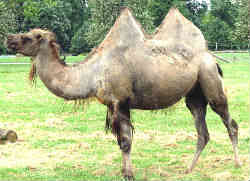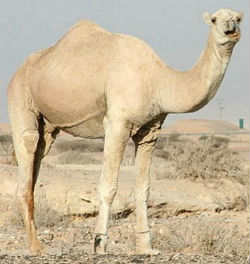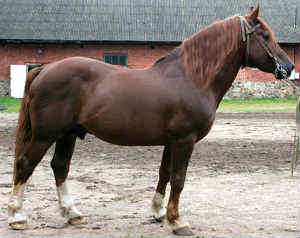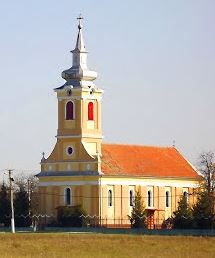Camel-horse Hybrids
Mammalian Hybrids
EUGENE M. MCCARTHY, PHD GENETICS, ΦΒΚ
This page was a draft for a chapter about camel-horses that has now been published in its finished form in my book Telenothians, which is available here.
|
Hippocamelus: a fabulous animal, half horse and half camel.
—Lewis and Short
A Latin Dictionary |
In Romania, during the predawn hours of June 29, 2014, a mare gave birth to what seems to have been a camel-horse hybrid in Zărand, a commune in Arad County. The severed head and neck of this strange creature, which was stillborn, are pictured below. It is unclear whether the camel parent would have been a Bactrian camel or a dromedary—both in the present case and in a second case, quoted below—although the coloration of this ostensible hybrid seems more reminiscent of C. bactrianus. It is not even certain that the two births in question, though both birthed by mares and both resembling camels, actually were camel-horse hybrids, given that it seems that no specimen was preserved and that no DNA tests have occurred. In the second case, however, it is known that the mother mare was confined with camels. Moreover, creature shown in the pictures below certainly looks more like a camel than a horse, even though it was foaled by a mare.
Although the skull of the Zărand animal was grossly deformed by intracranial pressures, which also bulged its eyes, it can be seen that the coat color of this animal, and its general physiognomy, are reminiscent of a camel. Reports say it also had the elongated legs of a camel, as well as the long and slender neck. A translation of a Romanian language news story reads as follows:
Arad community residents in shock: People froze when they saw what came out of a mare
People in the Arad town of Zărand are in shock and praying in church after a mare gave birth to a colt there that looks more like a camel with bulging eyes.
Locals believe it’s a bad sign, coming before Easter, and say they’ve never seen such a scary being.
“I have something here that I’ve never seen in my life,” said the owner of the animal, according to arq.ro [a local online news source].
The mare gave birth last night, dying in labor. The colt lies in the owner’s farmyard, people standing about, in shock at the way it looks.
Meanwhile, the owner says he’ll ask the local veterinarian, who was not present during the delivery, for compensation. The vet, who is supposed to be responsible for Arad County, is still nowhere to be found.
Meanwhile, local women are going to church to pray, believing the mutant colt is an evil omen.
“I have not seen anything like this in the 51 years of my life,” said one, “not since I was born.”
[Translated by E.M. McCarthy (with the help of Google Translate)]
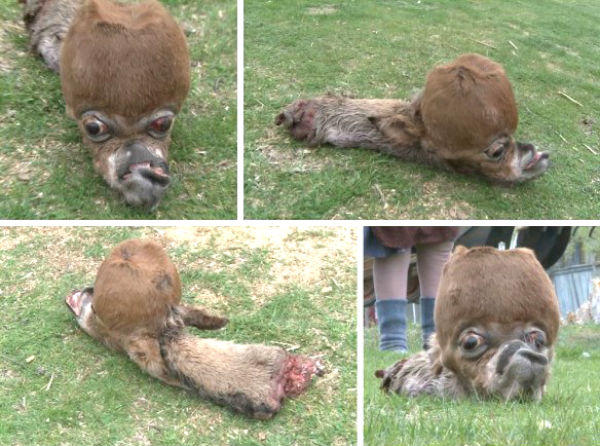 Severed head and neck of an ostensible camel-horse hybrid birthed by a mare in the Romanian community of Zărand in 2014.
Severed head and neck of an ostensible camel-horse hybrid birthed by a mare in the Romanian community of Zărand in 2014.
Other
Artiodactyl-equid Crosses:
The residents of Zărand are not the first to be affrighted by strange hybrids. Abnormal births have been considered ominous since ancient times. Indeed, the word monster comes from Latin monere, meaning to show or indicate. Like comets, eclipses and other rare portents, hybrids have been taken as harbingers of evil things to come. And many people have such feelings about strange hybrids even today, as evidenced by the reaction of the Christian women of Zărand.
A notice about a camel-horse hybrid born at Kanawha, Iowa, appeared in the Marshalltown, Iowa, Evening Times-Republican (Jul. 3, 1901, p. 5, col. 2). The report originally appeared in the Kanawha Record.
Another report, about a cyclopean camel-horse hybrid, describes a case in which a mare housed with circus camels later gave birth to a cyclops “colt” that had evident traits of a camel. The story appeared in the San Francisco, California, Call (Mar. 29, 1902).
THOROUGHBRED COLT WITH A CAMEL’S HEAD
Queer Freak Is Born at the Ranch of Samuel Parker Near Milpitas
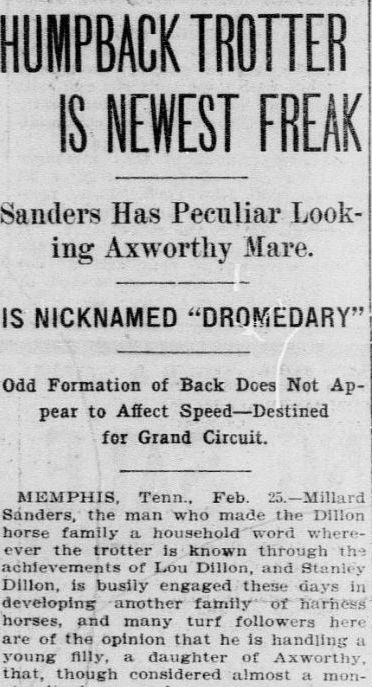
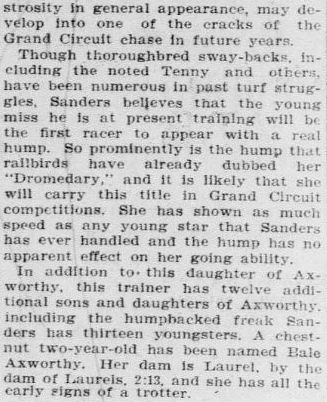 A news story about a "humpbacked" horse named Dromedary. Perhaps a camel-horse hybrid? (From: The Washington Times, February 26, 1905, Page 9).
A news story about a "humpbacked" horse named Dromedary. Perhaps a camel-horse hybrid? (From: The Washington Times, February 26, 1905, Page 9).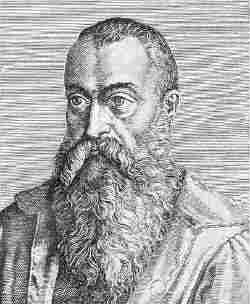
(1484-1558)
An advertisement about a viable camel-horse hybrid appeared in the October 5, 1906, issue of The Barre Daily Times, a newspaper published in Barre, Vermont (source).
Perhaps then, since eyewitnesses thought the creatures described in the reports above looked like camel-horse hybrids, they actually were camel-horse hybrids? The notion is made more plausible by that fact that many horse-cow hybrids (“jumarts”) have been reported. But only with further investigation will this question be resolved.
The old Latin name for a camel-horse hybrid is a hippocamelus. Hippocamelus is also a genus of deer comprising the huemul (Hippocamelus bisulcus) and the taruca (H. antisensi).
Although it is often said that horses are afraid of camels and will not tolerate their presence, when accustomed to each other, these animals can be on very friendly terms, as evidenced in the video below. Buffon (Histoire Naturelle, Générale et Particulière: supplément, vol. 3, pp. 39-40) even notes that female camels will nurse foals and young horses. There seems to be very little information available bearing on the question of whether camels and horses sometimes mate, but an early writer, the Italian scholar and physician Julius Caesar Scaliger (Exotericarum exericitationum, 1612, p. 649) says that mares will allow camels to mount them—a claim that seems to be borne out by the reports of ostensible hybrids, foaled by mares, quoted above.
By the same author: Handbook of Avian Hybrids of the World, Oxford University Press (2006).
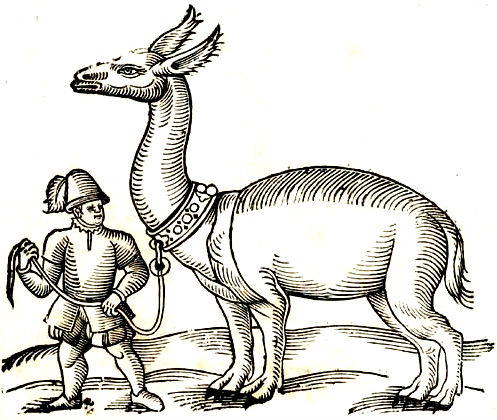 The allocamelus, as pictured in Edward Topsell's History of Four-footed Beasts (1608). Topsell thought this animal was the product of hybridization between a mule and a camel. However, it is now thought that his Allocamelus was in fact a llama. Of the allocamelus, Topsell writes: “Scaliger affirmeth, that in the land of the Giants [i.e., Patagonia], there is a beast which hath the head, neck, and ears of a Mule, but the body of a Camel; wherefore it is probable, that it is conceived by a Camel and a Mule, the picture whereof is before set down, as it was taken from the sight of the beast, and imprinted with a description at Middleborough in the year 1558, which was never before seen in Germany, nor yet spoken of by Pliny.”
The allocamelus, as pictured in Edward Topsell's History of Four-footed Beasts (1608). Topsell thought this animal was the product of hybridization between a mule and a camel. However, it is now thought that his Allocamelus was in fact a llama. Of the allocamelus, Topsell writes: “Scaliger affirmeth, that in the land of the Giants [i.e., Patagonia], there is a beast which hath the head, neck, and ears of a Mule, but the body of a Camel; wherefore it is probable, that it is conceived by a Camel and a Mule, the picture whereof is before set down, as it was taken from the sight of the beast, and imprinted with a description at Middleborough in the year 1558, which was never before seen in Germany, nor yet spoken of by Pliny.”
In addition, Albrecht von Haller (1774, vol. 1, p. 562; ||pd2t3g6) mentioned a foal that resembled a camel, and commented that it had cloven hoofs and callouses on its knees.
